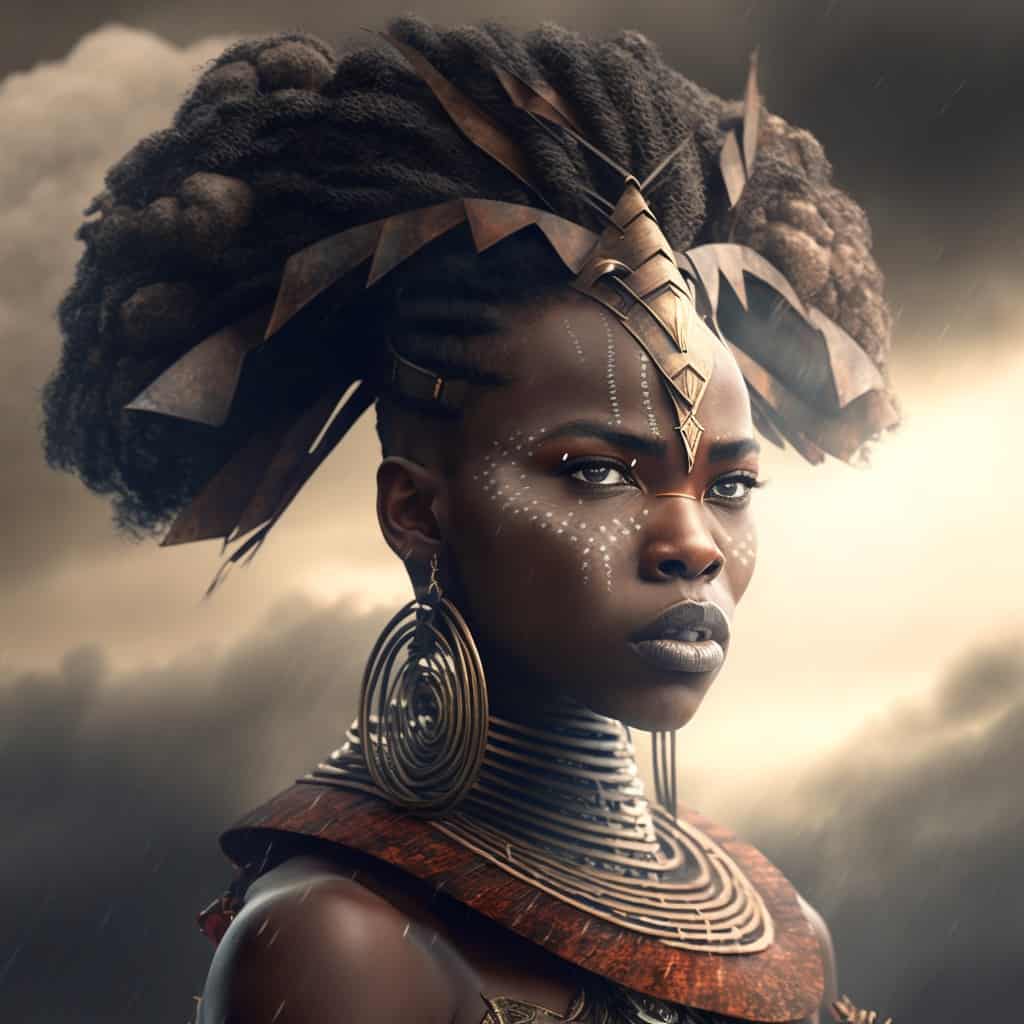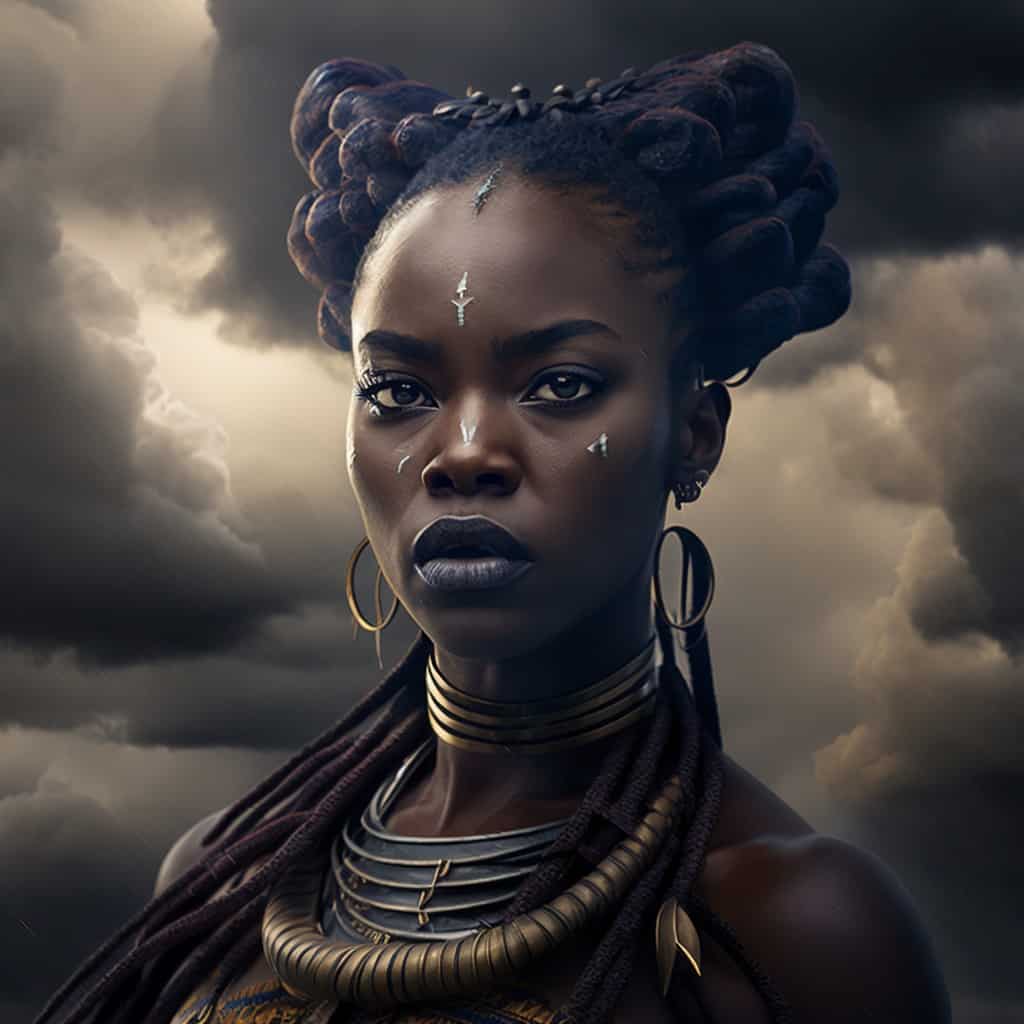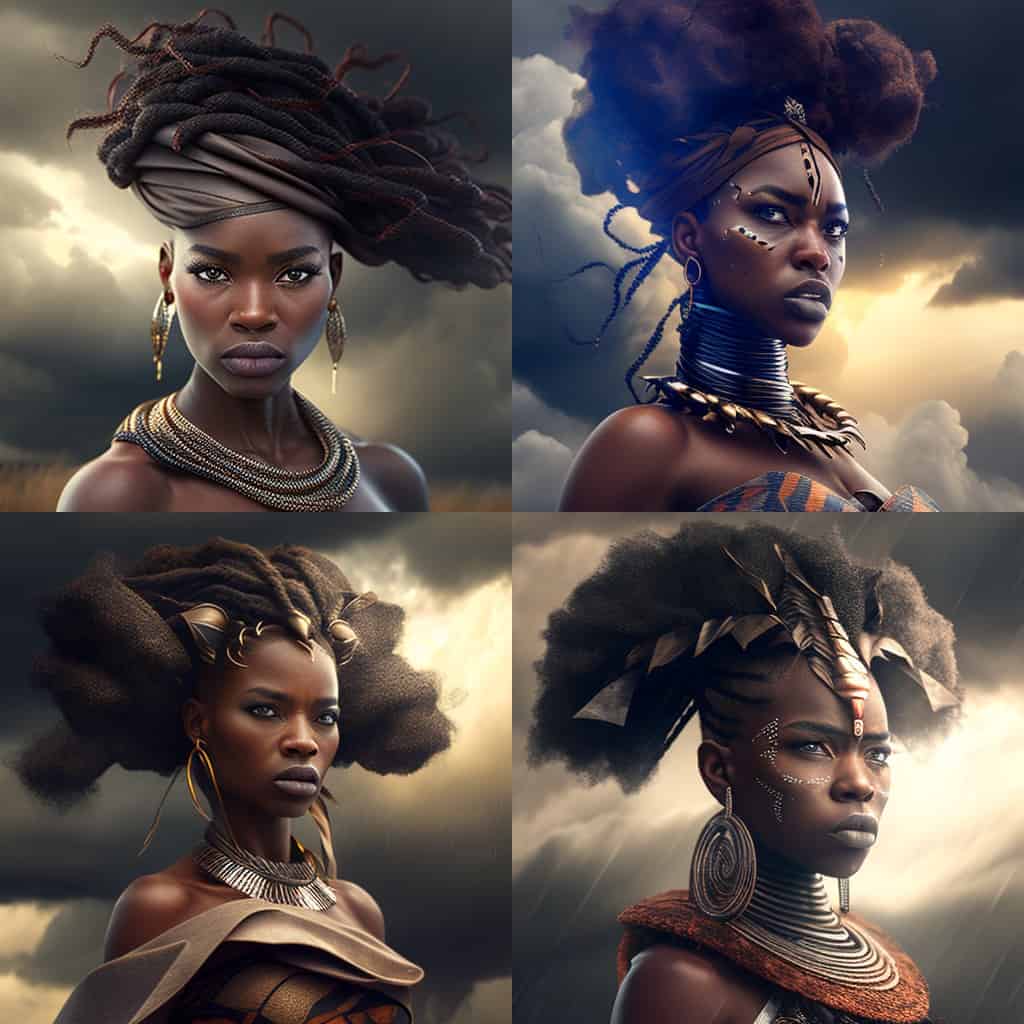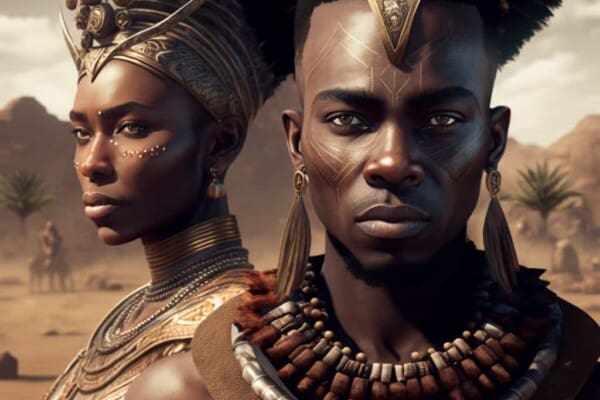According to the Yoruba religion, Oya is the goddess of the weather, and as such she is believed to be one of the strongest and most influential goddesses in all of Africa.
She is usually portrayed as a very strong and brave warrior that is nigh unbeatable, being capable of taking on any threat with ease.
The Celtics actually have a similar goddess known as Brigitte, which serves as the goddess of the weather for them, and although they’re not the exact same deity, there are a lot of similarities between the two.
Knowing just how influential Oya is though, it’s no wonder that she portrayed so much in the Yoruba mythos. So, embark on this journey with us as we go over everything that makes Oya so interesting, starting off with the following:
The Many Names of Oya
The Orishas were the spirits that were originally sent by one of the three manifestations of Olodumare on Earth. Olodumare was the original Supreme God according to the Yoruba.
Why is this important to note? Because Oya was one such Orisha in the Yoruba pantheon. She was so important in fact that she actually had several different names, including:
- Iansa
- Yansa
- Oia
- Oya – Iyansan – This name directly translates to “The Mother of Nine”
- Oya – Oya
- Oya – ajere – This name directly translates to “The Carrier of the Container of Fire”
- Ayi Lo Da – This name directly translates to “She Who Turns and Changes”
- Ayabu Nikua – This name directly translates to “The Queen of Death”
The Mother of Nine
Oya and her brother Shango are believed to have been the children of the Great Sea Mother known as Yemaya.
Despite the fact that she is one of the most veneered figures in the Yoruba mythos, there is a lot of confusion regarding who her father is.
In some depictions of the story, it is believed that Oya was actually a stillborn child and that she was born out of nothingness.
As soon as she was born however, she took a sacred cloth that was rainbow colored and she decided to make a sacrifice out of it.
Again, there is a lot of confusion regarding who she made the sacrifice to, although it doesn’t really matter that much because thanks to it, she managed to give birth to 9 children.
These children were almost all twins, except for the last one who was known as Egungun. This is where Oya gets her nickname from, as she is most often times referred to as the “Mother of Nine” by the locals.
Modern Depictions of Oya
There isn’t a lot of other information regarding her early beginnings, although many people believe that she must have been married to her brother Shango.
This is heavily disputed though as a lot of people also believe that she could have married Ogun, the god of iron and metal work later on down the line.
Regardless of any of that, Oya was most often times portrayed wearing the color of wine, which is believed to have been her favorite color.
At the same time, she is usually shown with nine whirlwinds around her. This is a reference to her nine children.
The number nine is heavily associated with her and as such whenever you see it being referenced in any ancient Yoruba texts you should already know that it is referencing her.
With that being said, in some instances she is also seen wearing a turban on her head. This turban is twisted though, to the point where it almost seems to resemble the horns of a buffalo.
This is a reference to the fact that Oya will later on end up marrying the great god Ogun, who is most often times portrayed in the form of a buffalo.
The Symbolism of Oya
Interestingly enough, there are actually quite a few different symbols that are all associated with the goddess Oya.
But by far the most prevalent symbols that are linked with Oya are the sword, the machete, the horsetail flywhisk, lighting and the water buffalo.
This may seem like a few too many symbols as a whole, but do try to keep in mind the fact that she usually shows up in the form of a water buffalo, and because she is a warrior goddess, she can’t be seen without her weapons on her.
This is why in most depictions she can be seen carrying a sword or a machete in her hands, as she is the one that clears up the path ahead in order to allow it to grow better and higher than ever before.
Lighting on the other hand may seem a bit strange, but do try to remember the fact that she is the goddess of weather, so it’s no wonder that she is seen with the most destructive part of nature at her disposal.
But interestingly enough, she is also seen portrayed a lot with a series of masks around her. Nobody knows why this is or what the significance behind them could be.
Many people believe that it could be a reference to the nine children she bore or that it could be the faces of her followers, but again, nobody knows for sure.
The horse flywhisk is just as strange as it doesn’t seem to scream “Oya” in any way, shape or form, but even so, it is still considered to be a major symbol that is most often times shown alongside Oya.
Oya as the Goddess of Change and Nature
As mentioned previously, Oya was known primarily for being the goddess of weather, but even so this was not her only reason for existing.
She actually played a lot of different roles in the Yoruba religion, which is why she is hailed as being one of the top deities in the Yoruba theogony.
She could easily command the lighting, she could bring storms that would shatter the earth as we know it and she could bring about winds and tornadoes that would eradicate whole countries off the face of the planet in a matter of seconds.
The earthquakes she could spring forward were so powerful that whole cities would get devoured instantly, and she could practically do all of this at the same time if she wanted to bring devastation to a tribe.
But she was not an evil deity, so she never used her power to bully or harass humanity, quite the contrary actually.
Instead, she used her power to bring down dead wood, she would ravage forests to make room for new trees to grow and she would use her powers to support the forest as much as possible.
Oya as the Funerary Goddess
On top of being known as the goddess of weather, Oya was also often times seen as the funerary goddess of the Yoruba pantheon.
What this means is that she was actually the one to take the souls of the dead as she would gently take ahold of them and carry them onto the next world.
She also watched over the newly deceased as she helped them pass over from one life to the other. If you believed in this depiction, chances are that you referred to Oya as Ayabu Nikua, which directly translates to “The Queen of Death”.
Oya as the Protectress of Women
At the same time, Oya was believed to be a representation of femininity and of motherhood. This is because she did give birth to her nine children, as mentioned previously.
On top of that though, Oya was also often times depicted as the one to help women when they needed any help whatsoever.
So, if a woman were to be going through a conundrum, chances are that if she were to ask Oya for guidance, she would make sure that the woman would find the answers she’s looking for.
Not only that but Oya was also showcased as a great problem solver, as she was capable of handling horses and helping people with their problems no matter how complicated they may be.
Because of this, she gained yet another title, which was “The Queen of the Marketplace”. While this was a lot less popular than her other titles, it is important to note because people would ask for her guidance every now and then because of how smart and adaptive Oya was.
Oya as the Warrior Goddess
Even though she was a benevolent goddess that only wanted to help her followers, it is important to note that Oya was also a very fierce and quick to anger goddess that wasn’t afraid of fighting instead of talking her way out of a problem.
As such, Oya was both feared and loved all at the same time. Just like any mother out there, she loved and cared for her children, but she was also stern and capable of defending her children if they were ever in trouble.
At the same time, if push came to shove, Oya could easily fight her way out of any situation, becoming the warrior goddess that everybody feared.
She could destroy villages in a matter of seconds and she could end lives as soon as she lifted a finger. Oya could never tolerate dishonesty, deceit and injustice, and she punished any who dared make a mockery of her followers or her principles.
She is also known for being the patron of the Niger River, which also goes by Oda-Oya to the Yorubans, and as such it is believed that she still lives in that vicinity even to this day.
The Powers of Oya
Again, depending on which version of Oya you are referring to, she is known for having multiple powers, with most of them having to do with controlling the weather.
But besides those, Oya was also known for her psychic powers, she also had control over life and death, her intuition was so strong that she could never be tricked by anyone, not even the other gods, and on top of that she also had clairvoyance so she could always see the future clearer than the present.
She had all of those powers and more so that she could properly serve as the guardian of the graveyards.
Because of this title you may also see her being depicted a lot around cemeteries, as she is the one that protects your soul after you pass and even guides you to your new life.
A lot of the times, Oya is also referred to as the “Great Mother of Witches (Elders of the Night)”, and she is believed to be one of the strongest goddesses to have ever come out of the Yoruba mythos.
The Worshippers of Oya
Even though Oya was actually one of the most popular Yoruba deities out there, it is interesting to note that there were never any temples raised in her name.
To this day, we have not discovered a single Oya temple out there, and as such it is believed that nobody directly prayed to her per se.
Instead, what the experts believe is that because Oya was regarded as the patron of the Niger River, that’s where her followers would meet up and worship her.
It’s not a question of whether or not she had followers either, as she is believed to have been very popular all throughout Africa and Brazil.
Her followers would pray to her on a daily basis and they would give her offerings of Acaraje, this being a sacred food that only the Afro-Brazilians know of.
The Acaraje would be made by simply peeling or crushing beans, then turning them into balls and frying them up in palm oil.
Afterwards, the Acaraje would be used for rituals as the Yoruba believed that the gods and goddesses would listen to them if they offered them this sacred food.
Interestingly enough, nobody knows what exactly went into the making of the Acaraje, as it was never sold to the people, and only the most sacred members of the Yoruba society knew the exact recipe for it.
Frequently Asked Questions about Oya
In this section we will be answering any remaining questions you may have right now, including:
What is the Relationship Between Sango and Oya?
Oya is the third wife of Sango, the God of Thunder according to the Yoruba mythos. Sango was known for having two other wives besides Oya, with these being Osuna and Oba.
But, interestingly enough, Oya was notably his favorite because, according to the Yorubas, her abilities perfectly complimented Sango’s.
So, in the Yoruba mythos, every time you saw lighting, that was actually Oya announcing that her husband was about to show up, which is why thunder always follows after the lighting.
What Time of the Year Is Oya Worshipped?
Oya is always worshipped on the second of February, although this isn’t always the case as in a lot of other traditions, she is worshipped on the twenty-fifth of November.
Will Oya Offer Protection to Her Worshippers?
Oya is willing to give you everything you ask from her, as long as you worship her enough. She can give you the strength to get through the harshness of life.
She can assure you love, money and many more material things that you desire on a daily basis. But, do keep in mind that while you can pray to her for these things, it is not recommended that you only ask for material things from her.
Asking for things like money is okay but if that’s all that you ever ask for you may encounter Oya’s fierce temper as she scolds you as she would any child for your vice.
What is an Acceptable Sacrifice for Oya?
For the most part, it is believed that “akara” was the main offering that the Yoruba used to give Oya in the past.
Nowadays, the akara is made by crushing beans and frying them in balls inside hot palm oil. But, in the past it is believed that the akara was a much more unique meal, and the reason as to why the recipe was lost is because only few members of the society knew about it.
Conclusion
Well folks, there you have it, that’s the Yoruba Goddess of the Weather, Oya. There is a lot more to know about her, but this should give you a pretty decent idea of what she is all about.
She is a loving mother that will always help out her children, but at the same time she is not afraid to fight for them too.
She really is worthy of being worshipped, and it’s no wonder that Oya is believed to be one of the most popular deities in the Yoruba pantheon.










